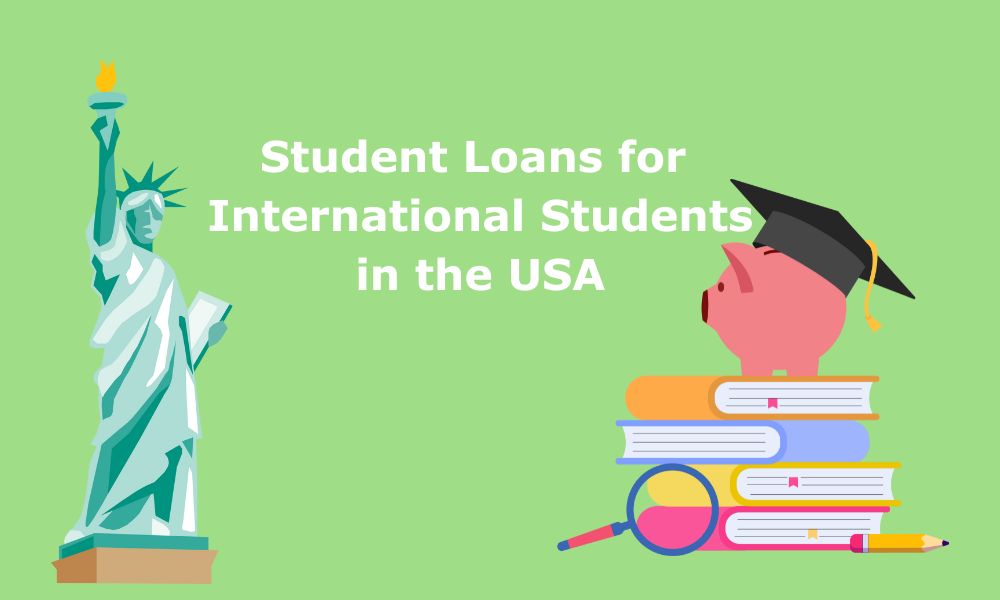The Olympic Games have long been a symbol of global unity, athletic excellence, and cultural celebration. Since their ancient inception in Greece, the Games have evolved into a massive international event, showcasing the pinnacle of human physical achievement and fostering a spirit of friendly competition. As we look forward to Paris 2024, the anticipation and…
How Much Student Loan Can I Get to Study in the USA?
Financing a college education in the United States often involves taking out student loans. The amount you can borrow depends on several factors, including the type of loan, your level of study, your financial needs, and whether you are an undergraduate or graduate student. Here’s a detailed breakdown of how much you can borrow to study in the USA.
Types of Student Loans
Student loans in the United States can be categorized into federal student loans and private student loans. Each type has its own borrowing limits and criteria.
Federal Student Loans
Federal student loans are generally the first option for students due to their favorable terms, such as lower interest rates and flexible repayment plans. Here are the main types of federal student loans and their borrowing limits:

1. Direct Subsidized and Unsubsidized Loans
- Undergraduate Students:
- Dependent Students:
- First Year: Up to $5,500 (no more than $3,500 in subsidized loans)
- Second Year: Up to $6,500 (no more than $4,500 in subsidized loans)
- Third Year and Beyond: Up to $7,500 per year (no more than $5,500 in subsidized loans)
- Total Limit: $31,000 (no more than $23,000 in subsidized loans)
- Independent Students:
- First Year: Up to $9,500 (no more than $3,500 in subsidized loans)
- Second Year: Up to $10,500 (no more than $4,500 in subsidized loans)
- Third Year and Beyond: Up to $12,500 per year (no more than $5,500 in subsidized loans)
- Total Limit: $57,500 (no more than $23,000 in subsidized loans)
- Graduate and Professional Students:
- Annual Limit: Up to $20,500 (all unsubsidized)
- Total Limit: $138,500 (includes undergraduate loans; no more than $65,500 in subsidized loans)
2. Direct PLUS Loans
- Graduate or Professional Students and Parents of Dependent Undergraduates:
- Borrow up to the cost of attendance minus any other financial aid received. There is no fixed annual or aggregate limit for PLUS loans.
3. Direct Consolidation Loans
- Allows you to combine multiple federal loans into a single loan. The limit depends on the sum of the balances of the loans being consolidated.

Private Student Loans
Private student loans are offered by banks, credit unions, and other private lenders. The borrowing limits for private loans vary widely based on the lender and the borrower’s creditworthiness.
Factors Influencing Private Loan Amounts
- Credit Score:
- Students or their cosigners need a good credit score to qualify for higher loan amounts and better interest rates.
- Income:
- Proof of sufficient income or a cosigner with adequate income is required.
- Cost of Attendance:
- Private lenders typically allow borrowing up to the cost of attendance, minus any other financial aid received.
- School Certification:
- Many lenders require school certification to verify the student’s enrollment and the loan amount needed.

Steps to Determine Your Loan Amount
- Calculate Your Cost of Attendance (COA)
- The COA includes tuition, fees, room and board, books, supplies, transportation, and personal expenses.
- Schools provide an estimated COA on their websites or through their financial aid offices.
- Assess Your Financial Need
- Financial need is determined by the difference between the COA and your Expected Family Contribution (EFC), as calculated by the FAFSA.
- Consider Other Financial Aid
- Scholarships, grants, and work-study can reduce the amount you need to borrow.
- Review Loan Options
- Start with federal student loans due to their favorable terms.
- If additional funds are needed, consider private student loans.
- Understand Borrowing Limits
- Stay within federal borrowing limits and only borrow what you need.
- Use private loans to fill any remaining gaps, ensuring you do not overborrow.
The amount of student loan you can get to study in the USA depends on whether you opt for federal or private loans, your level of study, your financial need, and your creditworthiness. Federal loans have set annual and aggregate limits, while private loans can vary based on several factors. By carefully evaluating your financial situation and understanding the borrowing limits, you can secure the necessary funds to support your educational journey without incurring excessive debt.

How to Get Financial Help for International Students in the USA
Pursuing higher education in the United States is a dream for many international students. However, the cost of tuition, fees, and living expenses can be quite high. Fortunately, there are various financial aid options available for international students to help manage these expenses. Here’s a detailed guide on how to secure financial help as an international student in the USA.
1. Scholarships
Scholarships are one of the most sought-after forms of financial aid because they do not require repayment. They are awarded based on various criteria such as academic merit, talent, and financial need. Here are key points to consider:
a. University-Specific Scholarships
- Merit-Based Scholarships: Many U.S. universities offer scholarships based on academic excellence. Criteria may include high GPA, test scores (such as SAT, ACT), and other achievements.
- Need-Based Scholarships: Some universities provide need-based scholarships to international students. The eligibility and amount awarded can vary widely.
- Departmental Scholarships: Specific departments within universities may have funds allocated for outstanding students in particular fields of study.

b. External Scholarships
- Government-Funded Scholarships: Programs like the Fulbright Foreign Student Program provide full scholarships for international students to study in the USA.
- Non-Governmental Organizations (NGOs): Various NGOs offer scholarships to students from specific countries or regions. Examples include the Joint Japan/World Bank Graduate Scholarship Program.
- Private Foundations: Organizations such as the Rotary Foundation offer scholarships for international students.
c. Country-Specific Scholarships
- Some countries have agreements with the USA to provide financial aid for their students studying abroad. Check with your home country’s education department for such opportunities.
2. Grants
Grants, like scholarships, do not require repayment. They are usually awarded based on financial need or specific criteria related to the student’s field of study or background.
a. University Grants
- Some U.S. universities offer grants specifically for international students. These grants can help cover tuition and other expenses.
b. Research Grants
- For graduate students, research grants are available from universities, private organizations, and government bodies to support specific research projects.
c. Field-Specific Grants
- Various professional associations and organizations offer grants to students pursuing studies in particular fields, such as science, technology, engineering, and mathematics (STEM).

3. Assistantships
Assistantships are a form of employment that provides a stipend and sometimes includes tuition remission in exchange for work.
a. Teaching Assistantships (TAs)
- International graduate students can work as teaching assistants, helping professors with instructional responsibilities.
b. Research Assistantships (RAs)
- Research assistantships are available to graduate students, particularly those in research-intensive fields. Responsibilities include assisting faculty with research projects.
c. Administrative Assistantships
- Some universities offer administrative assistantships where students assist with administrative tasks within departments or offices.
4. Loans
Loans for international students typically require a U.S. cosigner due to the high risk associated with lending to non-residents. However, there are some options available:
a. Private Student Loans
- Companies like Sallie Mae and Citizens Bank offer loans to international students with a U.S. cosigner.
- Some lenders, like MPower Financing and Prodigy Finance, specialize in offering loans to international students without requiring a U.S. cosigner, though they may have higher interest rates.
b. Home Country Loans
- Some international students obtain loans from banks or government programs in their home countries to fund their education abroad.
5. Work-Study Programs
International students on F-1 visas are permitted to work part-time on campus (up to 20 hours per week) during the academic year and full-time during breaks.
a. On-Campus Employment
- Jobs can include working in libraries, dining halls, administrative offices, or as campus tour guides. These jobs help cover living expenses.
b. Curricular Practical Training (CPT)
- CPT allows international students to work in internships or practical training programs that are part of their curriculum.
c. Optional Practical Training (OPT)
- OPT provides international students the opportunity to work in the U.S. for up to 12 months (or 24 months for STEM graduates) after completing their degree.

6. Sponsorships
Some students may receive sponsorships from corporations, governments, or other organizations.
a. Corporate Sponsorships
- Some multinational companies sponsor students in return for a commitment to work for the company after graduation.
b. Government Sponsorships
- Certain governments sponsor their citizens to study abroad with the expectation that they will return to contribute to their home country’s development.
7. Financial Aid from Home Country
Some countries offer financial aid to students studying abroad. This aid can come in the form of scholarships, grants, or low-interest loans.
a. Government Programs
- Check with your country’s education department or ministry for any programs that support international study.
b. Private Organizations
- Various organizations in your home country might offer financial aid to students studying abroad.
8. Crowdfunding
Crowdfunding has become a popular way for students to raise funds for their education. Platforms like GoFundMe, Kickstarter, and Indiegogo can help you reach a broad audience.
a. Create a Compelling Campaign
- Share your story, educational goals, and how the funds will be used.
b. Leverage Social Media
- Use social media to share your campaign with friends, family, and your community.
9. Reducing Costs
In addition to seeking financial aid, international students can take steps to reduce their educational costs.
a. Community Colleges
- Starting at a community college can be a cost-effective way to complete the first two years of undergraduate education before transferring to a four-year university.
b. Living Off-Campus
- Finding more affordable housing options off-campus can significantly reduce living expenses.
c. Meal Plans
- Opt for cost-effective meal plans or prepare your own meals to save on food costs.
d. Textbook Alternatives
- Use digital textbooks, library resources, or buy used books to cut down on textbook expenses.
Securing financial aid as an international student in the USA involves exploring various options, including scholarships, grants, assistantships, loans, and work-study programs. It’s crucial to research and apply for multiple opportunities, maintain strong academic performance, and seek financial aid early. By leveraging these resources, international students can alleviate the financial burden and focus on their academic and professional goals in the United States.




Very interesting subject, regards for posting.Expand blog